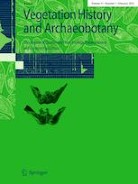Attribution & Copyright: Springer-Verlag GmbH Germany, part of Springer Nature
Artikel – Projekt 10 – Inneres Kongobecken
K. Neumann / B. Eichhorn / H.-P. Wotzka, Iron Age plant subsistence in the Inner Congo Basin (DR Congo). Veget Hist Archaeobot, 2022, doi: https://doi.org/10.1007/s00334-021-00865-8
Abstrakt (Quelle: Aufsatz):
Around 400 bc, pottery- and iron-producing populations immigrated into the Inner Congo Basin (ICB) and subsequently spread upstream some major tributaries of the Congo River. Until recently, their subsistence was almost completely unknown. We present an archaeobotanical study of three sites in the ICB covering parts of the Early Iron Age (ca. 400 bc–ad 650) and of the Late Iron Age (LIA) as well as subrecent times (ca. ad 1300–2000). We studied 82 flotated samples of botanical macroremains, and 68 soil phytolith samples, recovered from the terra firme sites Iyonda and Mbandaka, and the floodplain fishing camp site of Bolondo. The EIA assemblage from Iyonda yielded domesticated Cenchrus americanus (pearl millet), Vigna unguiculata (cowpea), Canarium schweinfurthii, Elaeis guineensis (oil palm), several wild plants, and parenchyma fragments tentatively attributed to Dioscorea sp. (yams). The exploitation of these plants originated in the savannas and forest-savanna ecotones of West Africa. The presence of C. americanus in LIA contexts at Bolondo and Mbandaka, dated to ca. ad 1350–1550, indicates that its cultivation is not dependent on a seasonal climate with a distinct dry season, contrary to previous views. The role of C. americanus as a staple is difficult to assess; it might have been used for special purposes, e.g. beer brewing. In spite of extensive screening, we did not detect any banana phytoliths in the EIA samples. Musa phytoliths were only present in LIA contexts after ca. ad 1400, leaving room for the possibility that the introduction and spread of Musa spp. AAB ‘Plantain’ in the ICB was a late phenomenon.




8. Juni 2023
… [Trackback]
[…] Find More Informations here: dainst.blog/entangled-africa/publikation_2022_01/ […]